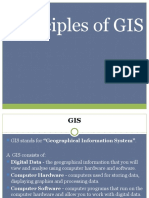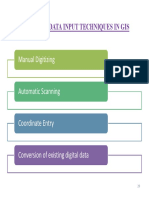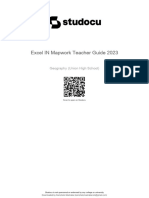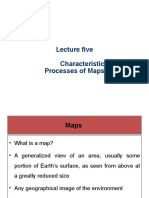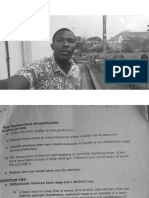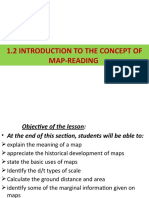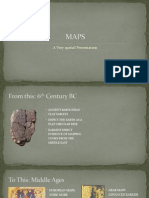0 ratings 0% found this document useful (0 votes) 12 views 17 pages Map Work Notes
The document provides an overview of mapwork skills, including locating exact and relative positions using latitude and longitude, and understanding bearings and magnetic declination. It explains the use of topographic maps, contour lines, and vertical exaggeration, as well as the functions and types of Geographical Information Systems (GIS). Additionally, it covers the structure of spatial data, the differences between raster and vector data, and the purpose of atlases and their indexes.
Copyright
© © All Rights Reserved
We take content rights seriously. If you suspect this is your content,
claim it here .
Available Formats
Download as PDF or read online on Scribd
Go to previous items Go to next items
Save Map Work Notes For Later Mapwork skills
Locating exact position
You can find any place on Earth by finding the point at which its line of
latitude and line of longitude intersect, All of South Africa is south of the
equaler and east of the Prime Meridian through Greenwich in England.
tase
(ot
HSE 1 The relationship between degrees, minutes.and seconds
Each degree (*) can be subdivided into 60 minutes (°) and each minute
divided into 60 seconds ("). This subdivision enables us to determine the
position of any place of object very accurately. The geographic co-
ordinates must be described in full as degrees, minutes, and seconds
South and East,�Locating relative position
‘What is direction?
When we referto direction we use the points of a compass card to describe
the general direction from one feature to another (see Figure 3}.
Hat} Conserting map dianon ¥ ground ain�What is a bearing?
Bearings indicate direction and are measured using a protractor and given in degrees,
True bearing
True bearing
Figure 4). The starting point to determine true bearing is the north-south
line, North will then always be O°. True bearing is always measured
clockwise from marth at 0°,
the angle measured relative to the true north line (see
Fon a True ben
9. nagatic bearieg and magnesc dectration�Magnetic beating
Magnetic bearing is Ihe angle measured retalive to the magnetic north
line (see Figure 5). Remember that for South Africa, magnetic north abways:
les weet of trae north.
[PONE Haw rmaghetiecdecSination Is shewnien South Africa's wapegeaphic reaps
How do you calculate true bearing and magnetic bearing?
‘The magnetic decination of any specific map area is shown on eur
Sopagraphic maps,
* True bearing = magnetic bearing - magnetic dectnaton
Calculating area of regular and irregular shapes�Working with 1:50 000
topographic maps
+ Contours are shown as brows lines on maps. Contours jain all places of
equal height above mean sea level (0m).
* The Soulh Alrican 1:50 000 topographic maps have a contour interval
of 20 mi. On the 1:10 O00 erthophote mape the interval is 5 rm
* Contour lines close to each other indicate steep slopes,
* Cantourlines that are far apart show genile slopes.
eid ool
eer
TF IT TT
ly |
1 WEVA | | |
selec d Hh i, UL | Il | bi
a Be
Fost? Landforms andasseclaned canmours�Whatis vertical exaggeration used for?
Vertical exaggeration Is the daliberate vertical stretching of a cross
seclion to emphasise the heigh! of smaller landscape features such as
valleys, hills, low mountains. The ratio between the vertical scale and the
horizontal scale ts Known as the vertical exaggaratian,�Haar 1] Contour rap te cakulane grachert,�‘The vertical diflerence (VD) is the height of the beacon minus the height
of the wind pump.
VO=408,3m—320m
=aham
The horizontal distance between the beacon and the wind pump is 5,2.em
as measured on the map. This distance must be converted to metres,
Therefore 5,J om « map scale divided by 100 will give us the distance in
metres,
HO=5,3.cm™ 50000
00
=2850m
Gradient= VD =883m =4
HO 250m =O
written as. ratio 1:30
This means that for every 30 m walk these is a.climb of 1m.
et�Geographical Information Systems
Whatis a Geographical Information System (GIS)?
A Geographical Information System is a computerised system consisting
of hardware, seflware and methods that are designed to capture, manage,
manipulate, analyse, model, and display spatial geographic data
fon-spatial attribute data in order to solve complex planning and
Management problems, The concept of GIS consists of three separate
words namely, geography, information, and system,
well as,
What are the functions of a GIS?
GIS has many functions that can be organised inte the following groups:
© collecting and capburing data
© storing and managing data
* recalling and processing data
* transforming and integrating with ther dats
© analysing data
* displaying data as maps and information tables.
Spatially referenced data
Before geographic data can be used in. GIS il first must be spatially
referenced ina ¢o- ordinate system. This is known as georeferencing.�Fewr 1? te wearrede af georvlerereig af geegrachie data
Ww�‘Spatial resolution
Spatial resolution refers to the quantity of detail that can be detected. It
describes the size of the picture elements, or pies, that make up the
image.
‘Spectral resolution
Spectral resolution is the ability of the sensor to detect information aver
Several spectral bands-of the electromagnetic spectrum.
Different types of data: point, line, area and attribute
Spatial features can be classified as points, lines or area type features.
Springs, bridges, monuments, beacons and wind pumps are all
examples of point type features,
Fear 1B 1h nya GES aearey und nplays clfevent patil Feanunes.
© Spatial data, or geographical data, is data which describes the
shape and the absolute and relative position of all geographical
features or objects,
+ Non-spatial data, or attribute data, is information which describes the spatial
characteristics of the spatial features or objects,
Raster and vector data
18�Spatial data structures
Data structures supply the information that is needed by the computer to
create a spatial data model of the real world in
two differant formats used for differant types of data, Figure 19 illustrates the
difference between raster data and vector data.
format, There are
9�FEWRE 19 The fever between raster andlwecter dita sinxtares
Raster data
A raater dala structure displaye geographic features by means of arranged
patterns within # grid system of equare or rectangular cells. The position of
each cell is determined by the number of its raw and column.
Vector date
The weetor data structure shows geographic features in the formof basic
geometric abjects such as paints, lines and polygons.�Using atlases
What is an atlas and an atlas index?
An atlas is. a book with a collection of diferent maps showing a varioty of
interesting spatial infarmation at various scales. Ithas different types of
graphs, charts, photographs, diagrams, lables and text, These cover
topics such as health issues, population pyramids, biodiversity, history of
the Earth and humans, desertification and sail degradation, world statistics
and so on.
Aliases are divided into various sections. The index atthe back of your atlas
lists place names and features alphabetically, Next to the name of the
feature oF place is the description of type of feature, country, page number
where the place appears most prominently, an alphanurnerc reference
and the co-ordinates to the nearest minute,
Feee 20 Anformanae feomthe we nan aa
a�you set looting for infosmaten about a place or
feanute
1a tn the bade at the bach a the aia,
2 Ua the alphabetical at infind the rame ofa
place or feature, Allmaees ave indeved
aiphabebeally for nach Costinvent, country, City,
tone teen, meunuinn, bay oF any ather named
geographical feature:
| find the page sumer of the mae showing the
Dace ge feature. usualy ony arm vefererce
Gives alboujhihe sate scr may apsear an
manymnags.
4 Fired the peterence that indicates where the place
‘F featute name appears on the map. Tere
different references maybe used, an
aiphaauminic reference or ge opraghical
coordinates
ff you are feciung Hor snforreancn abet a ager OF
Ueme that yor are stachyina:
Gere tbe table of cstarey atthe Free of the
mln.
2 fend the themerpay mere ier Manes, chert,
ire the pag masters of reap in each pection of
Une alloy where you may fied eelevant mag at
nabonal, continersal ani giatal wales.
11 the there ou ate shyla 1: aK ated the
tafe of conans, Bags through the Las oa oe
tmbethet yout theme in anutithere tevered under
another beading.
‘Ue all the infotmalvon availabe. iecluding a
variety of macs, dterent hinds of graphs, dita
lables and photographs.�— sah wehara?
Vin weeding, eboareamen of meat
1 identifyand Characlersnth and relcenigs: ‘whet
écdinen problem Refeastsle olnueet. spsevenate ind
_mecometishatte RS sc
aan Paring foruard an educated gust abseh
| pppotheaia may bea pevutieremen ee a salinenos | Statement
he peptien: whee
Deciembatntermason ceeded — | A
Collen, deveibe Describe Haters emir dees, ‘where?
4 and record Koumuinpaslang phetee. mening | OTE 4 Fletd
velormation ——acerdema guremenaens ac rcansing | 18
sheers,
‘What paneres?
‘aalpve and ‘Protect tndenmusion wth uomsle few did it
4 wnerpret wut tethegets happen Class
internation Migs, Sagnemk gripe tee way it
happened?
‘ear sie
Fresentfindings Woes spor. posts er ara prsertannn | SA?
3 |andmake Meaning enctoties.and eggesning |
vroummendinions — solurians we
happen?�


